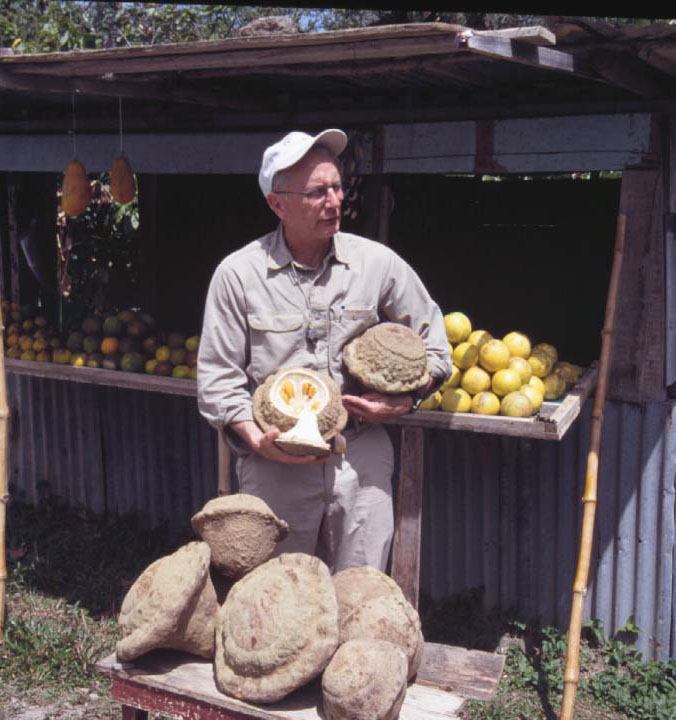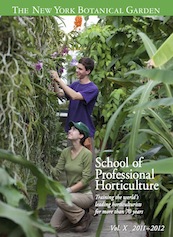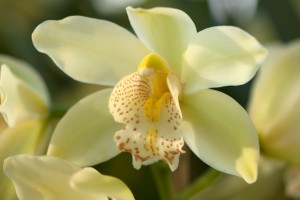Inside The New York Botanical Garden
Archive: March 2009
Posted in People, Science on March 4 2009, by Plant Talk
Batty for Brazil Nuts
During The Orchid Show: Brazilian Modern, Plant Talk takes a look at some of the research and conservation efforts of The New York Botanical scientists whose work is focused in Brazil. This interview was conducted by Jessica Blohm, Interpretive Specialist for Public Education.
 Dr. Scott Mori holds the giant, woody fruits of the
Dr. Scott Mori holds the giant, woody fruits of the sapucaia,
a species belonging to the Brazil nut family.
Photo by Carol Gracie“The diversity of Brazil is amazing,” Botanical Garden scientist Dr. Scott Mori says. “I grew up in Wisconsin, where there are 74 different species of trees in the entire state. In Brazil, there can be 300 different species of trees in the area the size of two American football fields. That means that every second tree that you look at is something different.”
Scott, who once met Roberto Burle Marx, the inspiration for this year’s Orchid Show, at a party in Brazil, is helping to preserve the Brazil nut family (Lecythidaceae), which includes the Brazil nut we eat and several hundred other species of magnificent, towering trees. Brazil nut seeds are easy to harvest because they are trapped inside woody, cannonball-like fruits that fall from the tree at maturity. These “packages of seeds” are simply picked from the ground and broken open to yield a harvest of 20 to 30 Brazil nuts per fruit. Brazil nuts are an economically important, non-timber forest product in the Brazilian Amazon.
Over the course of 40 years studying New World rain forests, Scott, the Nathaniel Lord Britton Curator of Botany, has described 51 new species of the Brazil nut family. His research has demonstrated many co-evolutionary relationships among species of the Brazil nut family and different animals, including bats and bees. Understanding these plant-animal interactions is an important part of understanding the plant’s biology and how best to conserve these plants. Scott co-authored Seed Dispersal by Bats in the Neotropics, which will be released in late April by NYBG Press.
“I am a hard-core scientist,” says Scott. “I go out into the field, collect plants, bring the specimens back here, and study the specimens.” This increased understanding of tropical plants, how they function and what they need to survive, often leads to efforts to conserve the rain forest habitats in which they are found.
Scott has shared his expertise on the Brazilian Amazon with Botanical Garden supporters on dozens of ecotours, combining informal natural history instruction with a myriad of other activities such as swimming in the tea-colored waters of the Rio Negro, hiking in the rain forest, fishing for piranha, early morning birding by canoe, and nocturnal trips for alligator spotting. He will lead his next ecotour, Ten Days in Brazil, October 10–21 with Botanical Garden President Gregory Long and James Miller, Ph.D., Dean and Vice President for Science. For additional information contact Brian Boom, Ph.D., Special Assistant to the President, at bboom@nybg.org or 718.817.8708.
Posted in Learning Experiences on March 3 2009, by Plant Talk
 |
Charles M. Yurgalevitch, Ph.D., is the Director of the School of Professional Horticulture. |
 This Friday (March 6), the School of Professional Horticulture will graduate 10 students who have successfully completed the intense, two-year horticulture training program. The program involves academic coursework, hands-on practical training, field trips, group projects, plant identification walks, a six-month internship and other activities.
This Friday (March 6), the School of Professional Horticulture will graduate 10 students who have successfully completed the intense, two-year horticulture training program. The program involves academic coursework, hands-on practical training, field trips, group projects, plant identification walks, a six-month internship and other activities.
Students enter the program with diverse backgrounds—such as Myung-Woo Yu from Korea, who graces the cover of the newest course catalog—yet with shared interests and goals to become professional horticulturists.
Within two years, they come to know the cultural needs of more than 1,000 plants and the common pests and diseases that accompany them. They leave the program with a strong and solid foundation in horticulture, confident that they are well prepared to succeed in a wide variety of horticultural venues.
The 10 students in the Class of 2009 have worked very hard to reach this moment, and I want to congratulate each and every one of them as we recognize their achievements.
Posted in Gardening Tips on March 2 2009, by Sonia Uyterhoeven
Steaming Things Up: Growing Orchids in the Home
 Sonia Uyterhoeven is Gardener for Public Education at The New York Botanical Garden.
Sonia Uyterhoeven is Gardener for Public Education at The New York Botanical Garden.
 One of the challenges of growing orchids in the home is maintaining reasonably high humidity levels.
One of the challenges of growing orchids in the home is maintaining reasonably high humidity levels.
A drywell, while not the most effective antidote, is a common solution and one of the easiest for many houseplants. Creating one is as simple as filling a tray with a layer of pebbles and water and placing the orchid on top, making sure that the pot rests above the surface of the water. The water from the drywell will evaporate around the plants. Placing an oscillating fan so that it gently blows are over the surface will increase the evaporation.
Better yet is investing in a humidifier. The humidity levels in your home will drop down to 15–25 percent in winter; a good humidifier can raise that back up to 40 percent. This higher humidity level is good not only for orchids, but probably for your wintertime dry skin and the furniture as well. Of the many wonderful books on orchids, one of my personal favorites is William Cullina’s Understanding Orchids, which has an informative chapter on different types of humidifiers.
Some orchids, however, are more demanding and require levels of humidity that are unrealistic for most homeowners. Occasionally, I hear of people who successfully grow epiphytic orchids in slatted cedar baskets that dangle beneath a skylight in their bathroom. If you have the room and the inclination to shower with your orchids, then this is fine; but for most of us, that is not a viable option.
One solution is to begin collecting miniature orchids and grow them in an old aquarium. A friend of mine grows orchids this way and fits about four or five miniature orchids in a 15-gallon tank. Fill the aquarium with 2 inches of clean pebbles and add water to just beneath the top layer of pebbles. You are essentially creating an enclosed drywell for the plants.
Circulation is an important consideration for healthy orchids, so it is best to leave the top of the aquarium open. While this growing system increases the humidity, the enclosed case can overheat in the sun, so it is important to monitor the growing conditions.
Once all the variables are in place, you have an opportunity to experiment with growing a delightful array of miniature orchids. To create a display of different heights, turn over an empty terra-cotta pot and use it as a stand for your orchids. To learn more about this setup and for an accessible, no nonsense approach to growing orchids, refer to Ellen Zachos’ book Orchid Growing for Wimps.
 Dr. Scott Mori holds the giant, woody fruits of the sapucaia, a species belonging to the Brazil nut family.
Dr. Scott Mori holds the giant, woody fruits of the sapucaia, a species belonging to the Brazil nut family.

 This Friday (March 6), the
This Friday (March 6), the 
